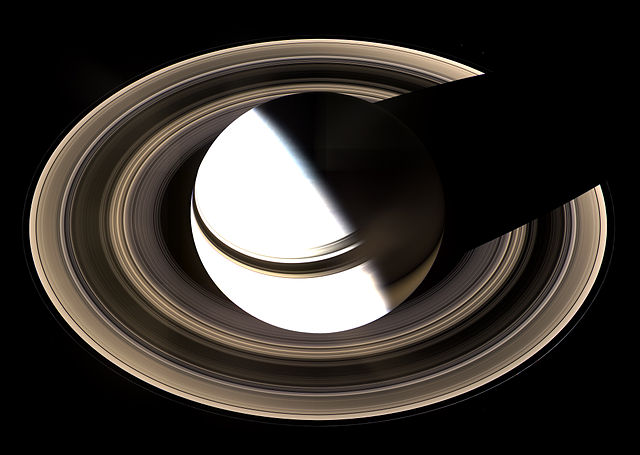
File:Saturn from Cassini Orbiter (2007-01-19).jpg

| |
This is a file from the Wikimedia Commons. Information from its description page there is shown below.
Commons is a freely licensed media file repository. You can help. |
Summary
| Target Name: | Saturn |
| Is a satellite of: | Sun |
| Mission: | Cassini |
| Spacecraft: | Cassini Orbiter |
| Instrument: | Imaging Science Subsystem - Wide Angle |
| Product Size: | 4088 samples x 2908 lines |
| Produced By: | Cassini Imaging Team |
| Primary Data Set: | Cassini |
| Full-Res TIFF: | PIA08362.tif (35.66 MB) |
| Full-Res JPEG: | PIA08362.jpg (671 kB) |
Blinding Saturn
Taking in the rings in their entirety was the focus of this particular imaging sequence. Therefore, the camera exposure times were just right to capture the dark-side of its rings, but longer than that required to properly expose the globe of sunlit Saturn. Consequently, the sunlit half of the planet is overexposed. The rest of the planet is cast in a hemispherical shadow.
Between the blinding light of day and the dark of night, there is a strip of twilight on the globe where colorful details in the atmosphere can be seen. Bright clouds dot the bluish-grey northern polar region here. In the south, the planet's night side glows golden in reflected light from the rings' sunlit face.
Saturn's shadow stretches completely across the rings in this view, taken on Jan. 19, 2007, in contrast to what Cassini saw when it arrived in 2004 (see PIA05429).
The view is a mosaic of 36 images — that is, 12 separate sets of red, green and blue images — taken over the course of about 2.5 hours, as Cassini scanned across the entire main ring system.
This view looks toward the unlit side of the rings from about 40 degrees above the ring plane.
The images in this natural-colour view were obtained with the Cassini spacecraft wide-angle camera at a distance of approximately 1.23 million kilometers (764,000 miles) from Saturn. Image scale is 70 kilometers (44 miles) per pixel.
Source: http://photojournal.jpl.nasa.gov/catalog/PIA08362 ( direct link)
| This image or video was catalogued by Jet Propulsion Lab of the United States National Aeronautics and Space Administration (NASA) under Photo ID: PIA08362. This tag does not indicate the copyright status of the attached work. A normal copyright tag is still required. See Commons:Licensing for more information. |
Licensing
| Public domainPublic domainfalsefalse |
 |
This file is in the public domain because it was solely created by NASA. NASA copyright policy states that "NASA material is not protected by copyright unless noted". (See Template:PD-USGov, NASA copyright policy page or JPL Image Use Policy.) |
 |
 |
Warnings:
|
File usage
Metadata
| Image title |
|
|---|---|
| Width | 4,088 px |
| Height | 2,908 px |
| Bits per component |
|
| Compression scheme | Uncompressed |
| Pixel composition | RGB |
| Orientation | Normal |
| Number of components | 3 |
| Horizontal resolution | 72 dpi |
| Vertical resolution | 72 dpi |
| Data arrangement | chunky format |
| Software used | Adobe Photoshop CS2 Windows |
| File change date and time | 15:27, 29 January 2012 |
| Colour space | Uncalibrated |
| Image height | 4,088 px |
| Image width | 2,908 px |
| Date and time of digitizing | 16:27, 29 January 2012 |
| Date metadata was last modified | 16:27, 29 January 2012 |
| IIM version | 2 |
A background to Schools Wikipedia
Through Schools Wikipedia, SOS Children's Villages has brought learning to children around the world. SOS Children helps more than 2 million people across 133 countries around the world. There are many ways to help with SOS Children.
